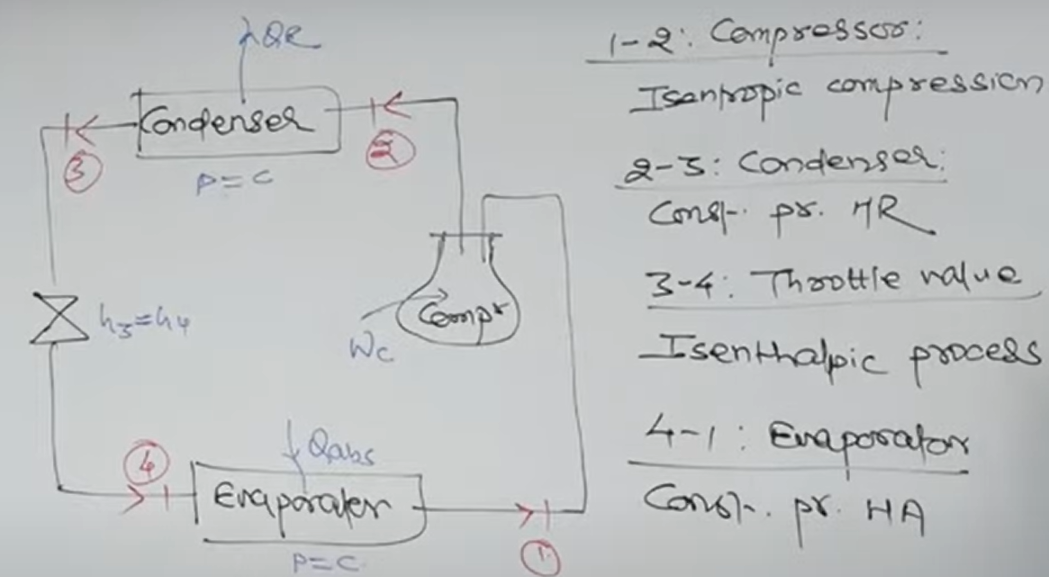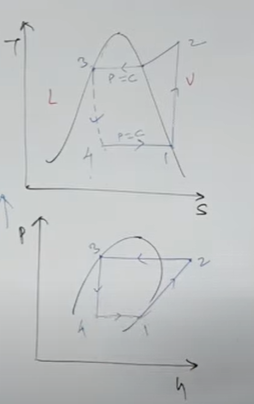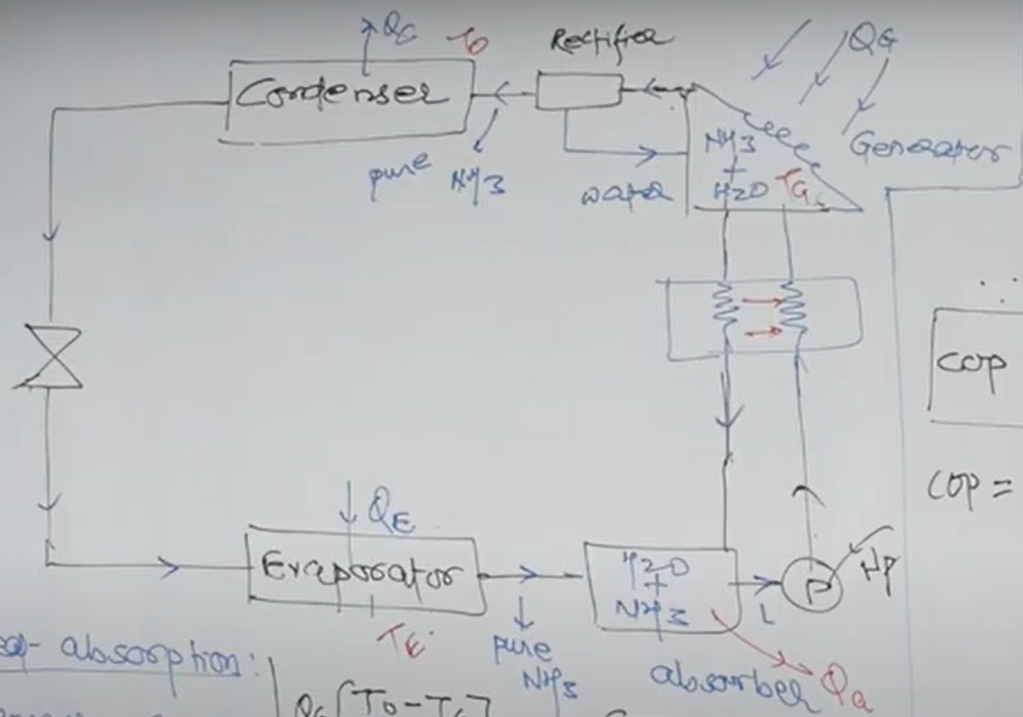In the last article, I talk about Refrigeration system basic concept, in this I am going to discuss about Various Methods of Refrigeration Cycle(Conventional and Non Conventional Methods).
So, lets start.
Definition of “Methods of Refrigeration”?
There are many methods of refrigeration cycle by using we can decrease the desire system temperature than surrounding, most popular is Vapour Compression Refrigeration system.
List of Methods of Refrigeration with Description-
There are several methods of refrigeration that are commonly used in various applications, including:
Vapor compression refrigeration:

This is the most common method of refrigeration, used in most refrigerators and air conditioning systems. It involves circulating a refrigerant gas through a closed loop system that includes a compressor, condenser, expansion valve, and evaporator.
The compressor pumps the refrigerant gas into the condenser, and the condenser cools and condenses it into a liquid. Then, the liquid flows through the expansion valve, which allows it to expand and evaporate into a gas. This evaporation process absorbs heat from the surrounding air or water, cooling it down. The cooled gas then flows back into the compressor to start the cycle again.
TS And Ph Diagram of Vapour Compression Refrigeration System-

Absorption refrigeration:

This method uses a heat source to drive the refrigeration process. People commonly use it in industrial settings and in applications where electricity is not readily available. In an absorption refrigeration system, the system evaporates a refrigerant, which a solution (typically lithium bromide) absorbs. Then, the system heats the solution, which releases the refrigerant as a gas. Next, the system condenses the gas back into a liquid, and the cycle repeats.Absorption refrigeration systems typically have lower energy efficiency than vapor compression systems, but can be useful in certain situations.
Thermoelectric refrigeration:
This method uses the Peltier effect, which occurs when a current passes through two dissimilar materials, to create a temperature difference. The temperature difference allows cooling on one side of the materials while heating the other side. People often use this method in small cooling applications, such as cooling electronic components or small refrigerators.
Magnetic refrigeration:
This method uses a magnetic field to control the temperature of a material. The material is typically a solid-state material, such as gadolinium or iron, that undergoes a change in temperature when exposed to a magnetic field. Passing an electric current through a coil creates the magnetic field, which people can turn on and off to control the temperature.Magnetic refrigeration has the potential to be more energy efficient than vapor compression systems, but is still in the experimental stages.
Steam jet refrigeration:
This method uses a jet of steam to create a vacuum, which lowers the boiling point of a refrigerant and causes it to evaporate, producing cooling. Typically, people use this method in industrial applications where they need high cooling capacities, such as in large refrigeration systems.
People use each of these methods with their own advantages and disadvantages and in different applications based on factors such as energy efficiency, cost, and cooling capacity requirements.
Natural Refrigeration Methods-
Natural refrigeration refers to the use of natural resources and processes to achieve cooling without the use of synthetic refrigerants. This approach is gaining increasing attention and popularity as a more environmentally friendly and sustainable alternative to conventional refrigeration systems that rely on synthetic refrigerants. Some examples of natural refrigeration methods include:
Evaporative cooling:
This method relies on the natural process of evaporation to cool air or water. The principle behind evaporative cooling is that as water evaporates, it absorbs heat from the surrounding environment, causing the temperature to decrease. Evaporative cooling can be used to cool indoor spaces, such as homes or warehouses, as well as outdoor spaces, such as patios or stadiums.
Ice cooling:
For centuries, people have used ice as a natural refrigerant. They produce ice using natural sources of cold, such as snow or ice harvested from lakes or rivers during winter months. They then store the ice in insulated containers or rooms and use it to cool food, beverages, or other products. People still use ice cooling today in some rural or remote areas where they have limited access to electricity or synthetic refrigerants.
Ground-source cooling:
This method utilizes the stable temperature of the ground to provide cooling. Ground-source cooling systems consist of underground pipes or loops filled with water or antifreeze that circulate between the ground and a heat exchanger located inside a building. The heat exchanger transfers heat from the indoor air to the circulating fluid, which then releases the heat into the ground. This process provides cooling in the summer and heating in the winter.
Overall, natural refrigeration methods offer a more sustainable and environmentally friendly approach to cooling than conventional refrigeration systems. They rely on natural resources and processes to achieve cooling without the use of synthetic refrigerants, which can have harmful effects on the environment and contribute to climate change.
Methods of Refrigeration Question with Solution-
Methods of Refrigeration MCQ’s with Solution for SSC JE-
1.Which of the following refrigeration cycles uses a single compressor and a single refrigerant?
A) Vapor compression cycle
B) Vapor absorption cycle
C) Gas cycle refrigeration
D) Stirling cycle
Solution: A) Vapor compression cycle
2. Which of the following is a disadvantage of using a cascade refrigeration system?
A) High initial cost
B) Limited range of operation
C) Limited refrigeration capacity
D) Requires more maintenance
Solution: A) High initial cost
3. Which of the following refrigeration methods is used in low-temperature applications, such as cryogenics?
A) Vortex tube refrigeration
B) Thermoacoustic refrigeration
C) Stirling cycle refrigeration
D) Joule-Thomson refrigeration
Solution: D) Joule-Thomson refrigeration
4. In a vapor compression refrigeration cycle, what is the function of the condenser?
A) To remove heat from the refrigerant and cool it down
B) To compress the refrigerant and raise its temperature
C) To reduce the pressure of the refrigerant and expand it
D) To evaporate the refrigerant and absorb heat from the surroundings
Solution: A) To remove heat from the refrigerant and cool it down
Short Questions and Solution on Methods and Refrigeration-
1. Which of the following refrigerants has the lowest boiling point?
Solution: A) R-508B
2. Which of the following is not a common refrigerant used in refrigeration systems?
Solution: D) Oxygen
3. What is the function of an evaporator in a refrigeration system?
Solution: To absorb heat and change the refrigerant from a liquid to a gas.
4. What type of compressor is commonly used in large commercial refrigeration systems?
Solution: C) Screw compressor
5. What is the primary advantage of using a thermoelectric refrigeration system?
Solution: They have no moving parts, making them very reliable and quiet.